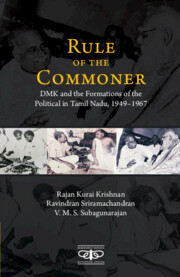10 - The Waves
Published online by Cambridge University Press: 15 June 2022
Summary
When the Dravidar Kazhagam (DK), formed in 1944 underthe leadership of Periyar and the stewardship ofAnnadurai, made a concerted effort to moot thedemand for an independent south Indian republic tobe known as Dravida Nadu, one question that had tobe confronted was, if a plebiscite was to be held onthe question, would people vote for the idea ofDravida Nadu? This naturally formed the corollary,whether there could be mass participation in protestaction or agitation to press for Dravida Nadu.Annadurai realized that they were in no position tobe assured of either. The origin of the Dravidianidea was a counter-hegemonic assertion againstBrahminic and casteist hegemony. If the JusticeParty elite who ruled the state under dyarchy werekeen on ensuring that Brahmins did not monopolizepower in the emerging state machinery and civilsociety, the Self-Respect Movement of Periyar waswaging a battle on the turf of the common sense ofthe people against Brahminism and casteism, andpatriarchy. As we have repeatedly noted, it was onlyafter the attempt to make Hindi learning compulsoryin 1937 by the Congress ministry underRajagopalachari did the threat of Brahmin hegemonytransforming into north Indian hegemony become apalpable reality, in and through the politicalvehicle of the Congress party with leverage fromfringe groups like the Hindu Mahasabha with theideational content of Hindutva, as we noted in ourreading of Arya Mayai(Aryan Allure) inthe first chapter. Since the transformation fromcounter-hegemonic struggles and articulations to ademand for an independent Dravidian country wasrecent in origin, there was a long way to go tomobilize people towards that end. Annadurai wasprescient in realizing that the idea of freedom, thedesire to become a self-governing republic, that hadspread in the process of the independence strugglethat the Congress had led should now form the basisfor the demand for an independent Dravidian countryas well. He saw them as successive stages ofhistory. This was in contrast with the stillcounter-hegemonic approach of Periyar, which madehim declare August 15, 1947, as a day ofmourning.
- Type
- Chapter
- Information
- Rule of the CommonerDMK and Formations of the Political in Tamil Nadu, 1949–1967, pp. 201 - 216Publisher: Cambridge University PressPrint publication year: 2022



